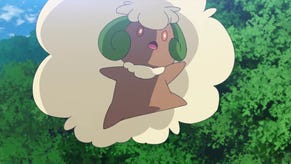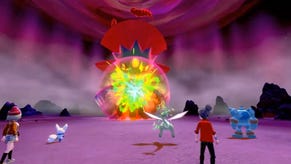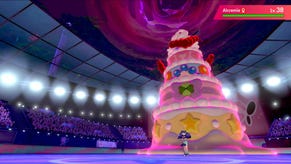Pokemon Sword & Shield interview: "we have no regrets" around the national dex
In many ways, Pokemon Sword & Shield have been decades in the making. I know that I've been daydreaming about what a big, main series console Pokemon title would look like since the late nineties - and thanks to Nintendo merging its handheld and console efforts in the Switch, it's now finally happening.
It hasn't all been smooth sailing. There was the whole national Pokedex controversy, and then when I played the E3 build of the game I was left rather disappointed - but a more recent hands-on with the game for an extended period has finally convinced me of exactly what is special about this latest Pokemon adventure. I get it now - I understand.
After that hands-on session at Pokemon's UK offices I got a chance to sit down with Pokemon Sword & Shield producer Junichi Masuda, while director Shigeru Ohmori joined us from Japan via video link. We discussed the Galar region setting of the game, the influence of Pokemon Let's Go on development, and that national dex controversy. Here's our chat:
VG247: This is your first non-remake sort of game on this new hardware... so how did you define the approach this time around? Was there a set approach from day one, or did you sort of gradually trend towards a direction as development moved forward?
Shigeru Ohmori: With designing this one, as you say it's the first kind of 'new' game on the Switch home console. The theme for making the game this time around was to make the 'strongest' Pokemon - in the sense that we've got the strongest graphics compared to what we've had in the past. We've got that Switch hardware, so we've really tried to make it the biggest world we can so far. Then there's even individual features - like the Dynamax feature gives you huge, really strong looking Pokemon. So everything is done with the kind of intent of creating a strong Pokemon game in those various meanings.
Doing so has really allowed us to make use of the Switch hardware and everything that offers - and that's how we approached the game development this time around.
VG247: So, why the UK for this game's setting? Obviously for us from here it's very cool, to see the Pokemon version of our home, but how did you guys settle on it?
Shigeru Ohmori: On a personal level, I really like UK music - UK rock music - and also some TV shows from the UK as well. So on a personal level that's kind of inspired me in the choice of the region. But on a more thematic level, we just talked about the theme of the strongest Pokemon... in terms of sort of historical, industry development, the industrial revolution, and also in terms of the modern day - things like sport play a role in the game - the UK is historically quite strong in these aspects as well. So when thinking of what the strongest Pokemon is, the UK came to mind as a really suitable area to base it in.
VG247: This is obviously a really stylized version of the UK, but what does the process look like to get to that? What is the research process like? Do you come out and do reference photography and stuff like that?
Shigeru Ohmori: As you say, it's not a full one-to-one representation of the UK, but it really is based on it and adapted to the Pokemon world. So of course as developers, from the start we don't necessarily know a huge amount about the UK, so one thing we did was go directly to the UK and look at different places. For example, on visiting the Lake District we were inspired by how pretty everywhere is, obviously the lakes...! [laughs] But also things like... there's a Peter Rabbit museum up there, and that inspires, like - all the different cute things and beautiful environments that you can see. That's something that we're very much inspired by, those on-site locations. Based on that we then look at how we can adapt it and fit it into the Pokemon world.

VG247: The last few years you've sort of been doing one of these big games every year - Pokemon has practically been a yearly series. Is that something you plan to continue with?
Junichi Masuda: The first thing that's kind of important in deciding the future direction is releasing Sword & Shield, it's seeing the response to that. That's an important part of where we go in the future. So it's not necessarily that we're looking always to release every single year, but each time we go into making a new game and start a new project we look at what exactly we want to create - and then from where we decide the most appropriate timing to release it depending on various factors.
One thing that we always want to keep in mind going forwards is that we want as many people to come in contact with and play Pokemon as possible. We've obviously got a lot of long-time fans who have loved the series for a long time, and we definitely want to keep making games that they love. At the same time we always want to draw in new players and make games that are accessible to them. So that's a really important thing we consider when starting a new project.
VG247: How do you manage to find the balance between the old and the new? It's sort of that impossible quandary of pleasing all these old fans but also... Pokemon has always been a franchise that's been focused on the kids, right? But then there's a lot of fans in their twenties and thirties still playing. How do you balance that?
Shigeru Ohmori: Balancing that sort of aspect is one really, really difficult element of development. The point that we always begin from is people who are coming into the game for the first time. So, for example, there might be a lot of players who played a lot of Pokemon Go but who have never played a main series game, and they're coming into this for the first time. We want to make sure that they can enjoy the game as much as anyone who plays it - be that for twenty years or two days.
This is why we always explain things like what the Pokemon world is all about, how it all works, how to throw a Pokeball and catch a Pokemon... all that basic stuff. We do start with the very basics and then gradually add in the other, more complex features. We also really try to make sure that everyone can approach the game on the same level. That is really our thought process.
VG247: So... what is the optimum route in now? I've got a friend who has got into Pokemon Go. What would the advice be that you'd give them? Would you say to them perhaps to play Pokemon Let's Go first, since it's a bit simpler? Or would you advise them to now just jump straight into Sword and Shield?
Junichi Masuda: Well, really what I'd say is... at the moment if someone is looking into the main series and they've only played Pokemon Go before, then Let's Go is out there... so until this is released in November, we'd really recommend they go and play that and have a good time. Then when this is released on November 15, they can pick up Sword or Shield... or Sword and Shield... and enjoy that as well. [laughs]
VG247: Ah, buy them both, of course. Buy them all!
Junichi Masuda: Well, the first thing is, please buy a Switch. [laughs]
VG247: Obviously this would've been in development before Let's Go released, but I'm curious about how Let's Go and the response to it might have influenced development. I was one of those people who when you guys announced Let's Go and revealed there were no random encounters, I was mad - and then when the game came out I was completely convinced, and even wrote an article supporting removing random encounters. In this, you've sort of gone half-and-half...
Shigeru Ohmori: To start with, producing Let's Go Pikachu & Eevee was a really good learning experience in terms of developing for the Switch for the first time, helping us on the way to developing this game. So on a very practical level, one thing that was difficult was we weren't sure how many wild Pokemon you could physically make appear on the overworld at the same time without causing trouble. Producing Let's Go was a way to discover that.
Seeing the feedback from fans, seeing that it was actually really well received that they could actually see the encounters on the map and decide if they wanted to take part or not... seeing that made us switch our direction towards it a little bit more, to increase the number of visible encounters we have in Sword & Shield a little bit more. So it really did have quite an influence on the development of this game.
VG247: So, we have to talk about the elephant in the room. At E3 you guys announced what you were doing with the Pokedex in this game, not having a complete national dex in the game. There was quite a response. Obviously you're doing what you're doing with this game, but has the response given you any pause for thought? Do you still think this is absolutely the only way to go in the future?
Junichi Masuda: It's not necessarily that it's made us rethink things per se, but what we are always looking at for the future is what we can do to make the most interesting game possible and make a more enjoyable, richer experience for the fans.
For example, when we add new moves and abilities we create a deeper experience for everyone to enjoy. This time around we can also give people a greater attachment to the Pokemon that are in the game, which is something we think is very important. So we definitely - we don't have regrets about what we've done.
In terms of having Pokemon that you had in previous games, we do have Pokemon Home that's coming out - and that's another place where everyone can gather all their Pokemon from previous games and enjoy a different way of playing with them there.
VG247: What's your approach to the game in a presentation sense? In the demo I played you've got the most sort of cinematic story scene that I've seen in a Pokemon game - there's perhaps some stuff in Sun and Moon that comes close - so was it exciting to do that stuff? I'm also curious about the decision to not have voice work - as it's striking to have these cutscenes with automatically progressing text boxes and lip flapping, but no voice.
Shigeru Ohmori: We really did want to make these cutscenes quite a focus from the start and make them more elaborate than usual. One thing that inspired us is the fact that we wanted to push the new hardware as far as we possibly could. These kind of scenes really allow us to show that off.
We can display scenes in much more detail than we've ever been able to, down to parts of the body moving that wouldn't before - like the lips, like you mentioned. We do think that we need to continue to adapt to the technology that we're using, figuring out what to put in and not to put in accordingly. On a practical level, we have a really big RPG with a lot of text that we're also developing in nine languages simultaneously. So the realities of implementing voicework on something like that, we do have to really decide if that's something we want to do, or even if it's practical. That nine language simultaneous release is something that we really heavily prioritized. Balancing that kind of thing is quite important to us.
Another small thing to add is that if you go in and add voice, you instantly give the players an impression of that character. If you don't do that, the players can read the text and imagine what that character might speak like and give them their own personality from their side. That's something that's quite nice. If we were to add voice, that might be lost a little. That's another consideration.
Junichi Masuda: If you get a really good bit of voice acting that's well recorded, that's really nice... but if you get some voice acting that's not great, that feels like it doesn't match the character, fans aren't going to be happy about that either! [laughs] Really, the most important thing for us is to have this worldwide release at the same time, have everyone be able to experience it simultaneously. Everyone can go out and find these new Pokemon and have a great experience at the same time.
VG247: I have to ask about the regional forms. Being from the UK it's exciting, as they're referencing our wildlife and our culture, and I could totally see that in some of the new ones I saw in the demo. But in design, how does it work? Do you just turn it loose on the artists? Are you thinking about specific Pokemon type combinations you'd like to see? Or are you thinking about the setting?
Shigeru Ohmori: What we do definitely think of is the unique characteristics of the region. So this time we're thinking about what might fit in with the UK as a regional space. But it's not just about creating a new individual regional form but also what would this Pokemon look like if it had a regional form and that regional form evolved?
Another idea is, you know, you've got Sirfetch'd, who has a very thick leek compared to the original leek that Farfetch'd carries... and that's inspired by the fact that leeks here are quite a lot thicker. So it's what fits with the region, but also what if a regional form evolved is a question we've been thinking about.
VG247: We've talked a little about the cutscenes and the presentation of the game, but one thing that hasn't changed as much is battles - they're still very much the same format, where visually they're quite static, with 'canned' animations for moves and stuff. Is there a temptation to try to make battles look more intricate, or do you think that's something that just isn't very possible with the number of moves and Pokemon in play?
Shigeru Ohmori: We do have some different battle features in terms of the presentation - one example is the dynamax battles where everything is a lot bigger, with a lot more pronounced animations and things like that... they're basically just a lot more over-the-top battles compared to what we've had before.
Another aspect is the battle camera you have in the gym battles... now you've got these stadiums, you've got these fans that are cheering you on and shouting out at different points in the battle. So there are certain aspects where we challenged ourselves to make things a little bit different this time around. What we'd really like to do is look at how fans react to those kind of changes and think about how we might like to change things in the future.



















